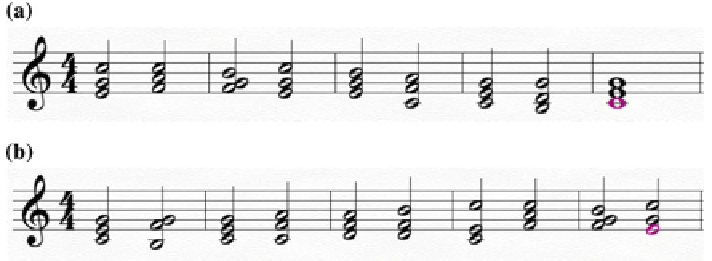Information Technology Reference
In-Depth Information
Fig. 15.6
Two phrases of diatonic music for use as a database
and voice-leading leaps, especially in the lowest line. However, as the examples
in Fig.
15.6
demonstrate, there is a clarity of progression that suggests function,
direction, key, cadence, and so on, all supported by the basic rules stated above.
All the chords here are triads or partial seventh chords (partial since seventh chords
require four pitches with only three pitches allowed here).
Voice leading, one of the most important factors in tonal music, requires that each
line (here designated from top to bottom as soprano, alto, and tenor) move as little
as possible, with the lowest line able to leap if necessary. Using half-steps as the
smallest interval here, the soprano in Fig.
15.6
a follows 0,
−
−
−
−
2, 0,
0. Note that no interval moves more than 2 (a major second, not a leap) and the
number of intervals is naturally one less than the number of pitches. The same is
true of the alto voice 2,
1, 1,
1,
2,
−
2, 0, 0
−
2,
−
1,
−
2, 2, while the bass has one interval
larger than a second (the
4 in measure 3), legal since the tenor is the lowest voice.
Figure
15.6
b follows the same principles with but one exception (the 5 in the alto
voice in measure 4).
In my topic
Computer Models of Musical Creativity
[
4
], I describe a computer
program called Emily Howell that I maintain is creative. It accomplishes this feat via
a human collaborator using a carrot and stick approach. I invite readers to explore not
only my description of Emily's processes in CMMC, but also the code available on
my website. As readers can tell frommy previous references in this chapter, however,
the program I will now describe requires that it operate creatively on its own.
Here, I begin by establishing three basic principles to which this program must
adhere. The first, and likely the most important, is simplicity. While some of my
software has become more complicated over the years, it never began that way.
The second principle involves something I maintain in all my work, that it be data-
driven. This means, simply, that the program requires as many appropriate examples
for analysis as possible. Finally, the third principle requires that each example in the
database be coherent in the sense that its context follows the same rule set. So, to
make myself clear, this program must be
−

Search WWH ::

Custom Search